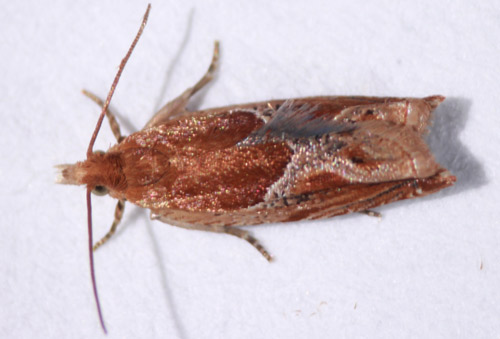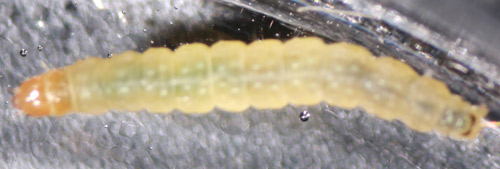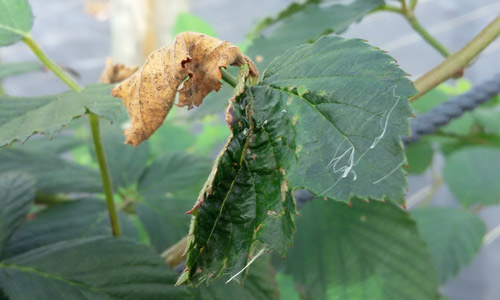common name: strawberry leafroller
scientific name: Ancylis comptana (Frölich) (Insecta: Lepidoptera: Tortricidae)
Introduction - Synonymy - Distribution - Description - Life Cycle and Biology - Host Plants - Economic Importance - Damage - Management - Selected References
Introduction (Back to Top)
Strawberry leafroller, Ancylis comptana (Frölich), is a reddish brown tortricid moth with distinct gray, tan and white forewing markings. It is considered a minor or occasional pest of strawberry in many areas of North America and Europe because of leaf tissue damage. Larvae use silk to spin webs and roll leaves while consuming leaf tissue.
Figure 1. Strawberry leafroller adult, Ancylis comptana (Frölich) (dorsal view). Photograph by Justin Renkema, University of Florida.
Synonymy (Back to Top)
Ancylis comptana (Frölich) – after Fink (1932)
Tortrix comptana Frölich, 1828.
Phoxopteryx comptana Duponchel, 1844.
Anchylopera comptana Wilkinson, 1859.
Grapholitha (Phoxopteryx) comptana Heinemann, 1863.
Grapholitha conflexana Walker, 1863.
Anchylopera fragariae Walsh and Riley, 1869.
Ancylis comptana Fernald, 1903.
Distribution (Back to Top)
Strawberry leafroller is found in eastern North America, occurring west to Illinois, Iowa, Oklahoma and Texas. It is also recorded from California, Colorado, Nevada, Alaska, the Pacific Northwest and several Canadian provinces. Strawberry leafroller was first observed in North America in Indiana in 1868 and was thought to have been introduced from Europe, but may have been originally distributed in both North America and Europe. Strawberry leafroller is found in most European countries and has been recorded in Mongolia and Korea.
Description (Back to Top)
Adults: Adult moths have a wingspan of 10 to 13 mm. Forewings are light to dark reddish brown, with lighter tan and white areas streaked with darker brown, particularly on distal ends. Hindwings are gray.
Eggs: The eggs are oval and attached to the leaf surface. The eggs change from pale green to yellow as they develop.
Larvae: The larvae progress through five instars, increasing from 1.5 to 12 mm in length. Prepupae grow larger before overwintering than prepupae of summer generations, in preparation for hibernation. For early instars, the head is brown and the body is pale green, but in later instars the head is a yellowish brown and the body is gray-brown, with a gray underside.
Figure 2. Strawberry leafroller larva, Ancylis comptana (Frölich) (dorsal view). Photograph by Justin Renkema, University of Florida.
Pupae: The pupae are 8.5 mm in length and change from yellowish to dark brown over time.
Life Cycle and Biology (Back to Top)
Strawberry leafroller has two or three annual generations, depending on latitude, with moths active in early spring, summer, and late summer if a third generation occurs. The number and timing of generations has not been described for sub-tropical regions, such as Florida. In temperate locations, overwintering larvae form pupae from which the first generation of moths emerge and lay eggs. Moths live for about two weeks, longer in cooler weather, dispersing locally onto suitable host plants.
Eggs are laid singly on the undersides of leaves; a female lays 20-120 eggs in her lifetime. After an incubation period of 5-17 days, first instars feed on leaf tissue and spin a silky covering near the base of the leaf between two prominent veins. The covering is enlarged as larvae grow, and larvae may move and start building a second covering on the same leaf. Eventually, larvae migrate to the tops of leaves and begin to fold and roll them together.
Pupae are formed within the leaf roll. The average duration of the entire larval period is 24 days and the pupal period is 6-18 days. Temperatures between 18 and 30°C (64-86°F) are optimal for larval development. Adult emergence is reduced to about 30% when temperatures are consistently below 14°C (57°F) or over 34°C (97°F).
Overwintering larvae undergo diapause (a state of hibernation), induced by shorter day length and lower temperature in early fall . Diapause is complete in about 3 months, and post-diapause development is directly related to temperature, requiring 154 accumulated degree-days over 10.5°C (51°F). Diapause in Florida populations has not been confirmed.
Host Plants (Back to Top)
Strawberry leafroller is found primarily on plants in the rose family (Rosaceae), including cultivated strawberry (Fragaria spp.) and blackberry and raspberry (Rubus spp.), as well as cinquefoil (Potentilla spp.), roses (Rosa spp.) and Dryas octopetala. It has also been recorded on small burnet (Sanguisorba minor) and thyme (Thymus spp.).
Economic Importance (Back to Top)
In the late 1800s and early 1900s, losses of up to 50% in strawberry yields in midwestern and eastern states were reported. Most of the loss was due to the early-season feeding by first generation larvae. However, strawberries have a relatively high tolerance for strawberry leafroller feeding, with no differences in larval development or ovipositional preference between more recently developed cultivars (1990s). Economic impacts of strawberry leafroller on raspberries and blackberries have not been reported.
Damage (Back to Top)
Damage caused by strawberry leafroller is confined to plant leaves; however, under heavy infestations fruit can become small and distorted due to severely affected plants. Larvae feed on and fold or roll leaves, causing shriveling and withering so that fields appear scorched or burnt when populations are high.
Figure 3. Feeding and leafrolling damage on cultivated blackberry (Rubus subgenus Rubus) due to strawberry leafroller moth, Ancylis comptana (Frölich). Photograph by Justin Renkema, University of Florida.
Figure 4. Feeding and leafrolling damage on cultivated blackberry (Rubus subgenus Rubus) due to strawberry leafroller moth, Ancylis comptana (Frölich). Photograph by Justin Renkema, University of Florida.
Management (Back to Top)
Low levels of strawberry leafroller infestation (about 10-20% of leaves infested) can be sustained by strawberries without causing economic losses and populations rarely reach high densities, therefore control is not often warranted.
Biological control: A suite of parasitoids have been recorded from strawberry leafroller larvae and pupae and contribute to keeping populations low. Some important species are Itoplectis conquisitor, Pediobus facialis, Macrocentrus ancilovorous and Cremastes cookii. A fly, Exorista pyste, also parasitizes larvae, and predators that have been observed feeding on larvae include the bugs Nabis americoferus and Podisus maculiventris (Hemiptera). In addition, strawberry leafroller has been shown to be a key alternative host for the parasitoid Colpoclypeus florus of dominant leafroller pest species (Tortricidae) in Washington state fruit orchards when Rosa woodsii or strawberries are close to orchards.
Cultural control: Where strawberry leafroller is a chronic problem, it is advisable to remove accumulated dead plant material where larvae may overwinter, and if feasible, to remove leaves that show signs of damage. Pinching to kill larvae in rolled leaves also may be an option.
Chemical control: A decision to apply insecticides should be based on scouting for damage or results of temperature models used to predict occurrence of egg hatch in the spring. First instars do not roll leaves, so are difficult to observe.
Selected References (Back to Top)
- Fink DE. 1932. Biology and habits of the strawberry leafroller, Ancylis comptana (Froel.), in New Jersey. Journal of Agricultural Research 44: 541-558.
- Gabriel AD, Obrycki JJ. 1990. Cultivar acceptance and suitability for preimaginal development of the strawberry leafroller (Lepidoptera: Tortricidae). Journal of Economic Entomology 83: 1514-1518.
- Gabriel AD, Obrycki JJ. 1990. Thermal requirements of preimaginal development of the strawberry leafroller (Lepidoptera: Tortricidae). Environmental Entomology 19: 339-344.
- Obrycki JJ, Gabriel AD, Orr CJ, Bing JW. 1990. Dormancy in the strawberry leafroller (Lepidoptera: Tortricidae). Environmental Entomology 19: 932-936.
- Obrycki JJ, Ormond AM, Gabriel AD, Orr CJ. 1993. Larval and pupal parasitism of the strawberry leafroller (Lepidoptera: Tortricidae). Environmental Entomology 22: 679-683.
- Powell JA, Opler PA. 2009. Moths of Western North America. University of California Press, Berkeley, USA.
- Unruh TR, Pfannenstiel RS, Peters C, Brunner JF, Jones VP. 2012. Parasitism of leafrollers in Washington fruit orchards is enhanced by perimeter plantings of rose and strawberry. Biological Control 62: 162-172.



